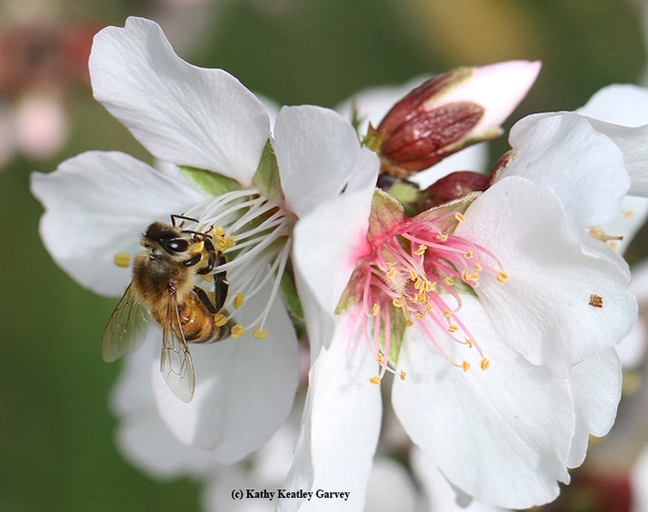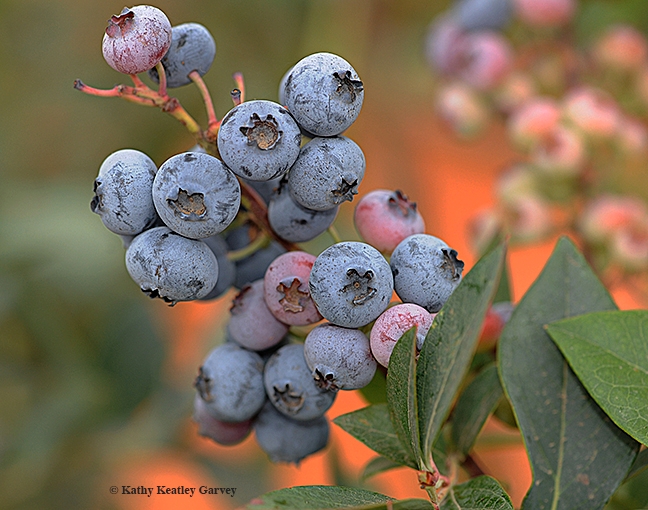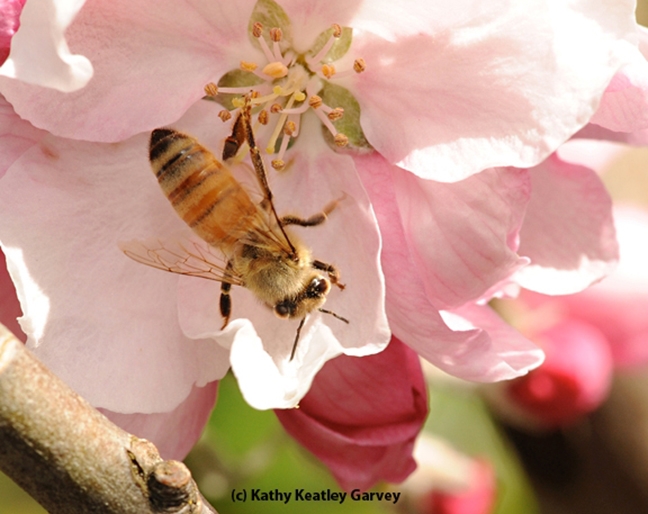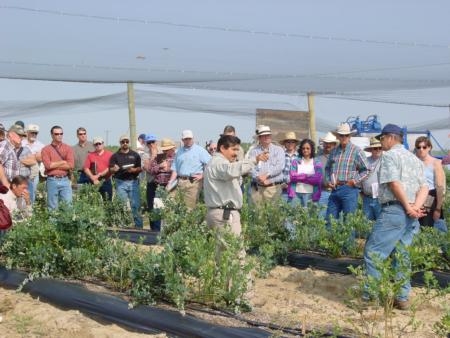Posts Tagged: blueberries
Free Webinars: Think of the ABCs in Pollination of Specialty Crops
Think of the ABCs: almonds, blueberries and cherries. Then think of watermelons and pumpkins. All those crops will be discussed in a series of free...

"A" is for almonds. A honey bee pollinating an almond blossom. (Photo by Kathy Keatley Garvey)

"B" is for blueberries. This is the result of bee pollination. (Photo by Kathy Keatley Garvey)

"C" is for cherries. A honey bee pollinating a cherry blossom.(Photo by Kathy Keatley Garvey)
Western Farm Press runs 1,000-word story on Kearney blueberry event
The annual Blueberry Open House at the UC Kearney Agricultural Research and Extension Center last month warranted lengthy coverage by Western Farm Press.
Freelance writer Dennis Pollock reported that Manuel Jimenez, UC Cooperative Extension advisor in Tulare County, a small-scale farming expert, walked among the mature blueberry plants at Kearney, describing their good points and bad points.
"The perfect blueberry would be one that is big, firm, sweet, easy to harvest and grows in high pH (soil conditions)," he said.
At the event, Richard Molinar, UCCE advisor in Fresno County, small-scale farming, conducted a blueberry tasting, allowing those who attended to vote for their favorite three varieties. He said that variety isn't the only factor impacting flavor.
"Flavor is also affected by weather, soil factors, plant nutrition and irrigation frequency," Molinar said.
Jimenez introduced growers to two new research projects in blueberries:
- Jimenez and Larry Schwankl, Kearney-based UCCE irrigation specialist in the UC Davis Department of Land, Air and Water Resources, have teamed to study the effects of varying irrigation levels on blueberries.
- Jimenez has grafted popular blueberry varieties onto the roots of farkleberry (Viccinium abroreum), which has greater tolerance of alkaline soils like those found in the San Joaquin Valley. By reducing or eliminating soil and water acidification, using the alternate rootstock may provide a significant cut in production costs.

Manuel Jimenez leads a tour of the 15-year-old blueberry research plot.
Not all blueberries are alike
As blueberries have become more a popular plant for home gardening, variety choices have blossomed, wrote Laura Christman in the Redding Record Searchlight.
When it comes to flavor it's hard to go wrong with any variety of homegrown blueberry, said Manuel Jimenez, a University of California Cooperative Extension farm advisor specializing in blueberries.
"All the varieties that ripen on the plant are good," said Jimenez, who is based in Tulare County.
Among the varieties Jimenez recommends are Misty, Reveille, Sharpblue, Star, Legacy, Emerald and Jewel.
The best time to plant blueberries is in the fall, when the ground is warm and plants can establish roots, Jimenez said. However, most nurseries don't feature them in fall. The biggest selection of blueberry plants is available now.

Manual Jimenez talks blueberries at the UC Kearney Agricultural Research and Extension Center last fall.
California blueberries are 10 days late
Persistent cool, wet weather has pushed California's blueberry ripening back 7 to 10 days, but farmers are expecting a bountiful harvest of the antioxident-rich fruit, reported the Fresno Bee today.
Typically, some varieties are ready at the end of April and "by the second week of May we're going," UC Cooperative Extension farm advisor Manuel Jimenez told Bee food writer Joan Obra.
Consumers rarely have the opportunity to select blueberries by variety, but the different types grown in California vary substantially.
Jimenez suggests, for tart, firm berries, go for the early-season Emeralds, Obra reported. A softer and sweeter option is the Jewel. The Reveille has lots of sweetness, while Southmoons have the best flavor and sweetness combination.
Farmers and industry representatives are participating in a blueberry and blackberry field day and tasting today at the UC Kearney Research and Extension Center. The public may sample 15 blueberry and 4 blackberry varieties at a berry tasting 8 to 11 a.m. June 12 at Bravo Lake Botanical Gardens, 200 E. Naranjo Blvd., in the Tulare County community of Woodlake.
Bravo Lake visitors will also have the opportunity to try Pakistani mulberries. According to the California Rare Fruit Growers, Pakistani mulberries have extremely large ruby-red fruit that is sweet and has fine flavor balance.

Manuel Jimenez at a previous blueberry field day.
U-pick and U-grow blueberry bargains
The Riverside Press-Enterprise may have the last word on blueberries for the 2009 season. Reporter Sean Nealon wrote two stories for last Saturday's paper about the Inland Empire's fledging blueberry industry.
One story reported on a Temecula blueberry farm where most of the fruit is harvested by the consumers themselves. The other story suggested that blueberries can make nice landscape plants. Both stories proffer the antioxidant-rich fruit with less strain on the pocketbook.
In the U-pick article, the reporter related information from UC Cooperative Extension's resident blueberry expert, farm advisor Manuel Jimenez of the UC Small Farm Program. He said California's blueberry acreage has increased from less than 20 to 5,000 to 6,000 in the past 12 years, most in the San Joaquin Valley. Blueberry production is labor intensive. A U-pick system cuts farm labor costs and the savings are passed on to consumers. In the store, blueberries are about $10 for 18 ounces. For Temecula U-pickers, the price is $5 per pint.
For the second story, Nealon spoke to Don Merhaut, an assistant UC Cooperative Extension specialist for ornamental and floriculture crops at UC Riverside. Merhaut started researching blueberries while a doctoral student at the University of Florida. After arriving at UCR in 2000, he began thinking more about blueberries' ornamental qualities -- their leaf texture, canopy, pink flowers, and, of course, delicious and healthful fruit, according to Nealon's article.
Merhaut recently completed a five-year study of 13 blueberry varieties in agricultural fields. He found 10 blueberry varieties that would make excellent landscape plants and plans to post a paper with his findings on the Internet.

Blueberries.

